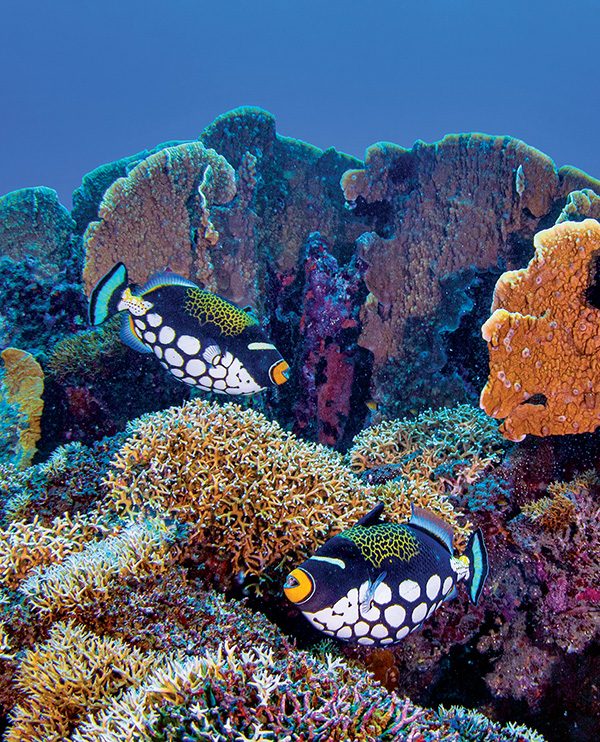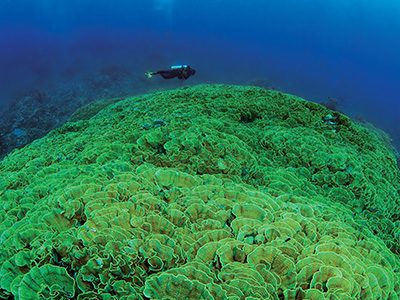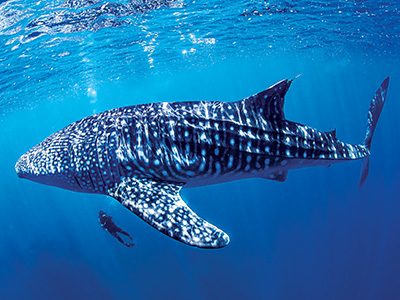Everything changed for Una-Una on July 14, 1983, when a volcanic eruption destroyed the central hub of Indonesia’s Togean Islands in central Sulawesi. Lava covered 90 percent of the island, and thick, black smoke rose into the sky more than 9 miles (14,5 kilometers) high. The Indonesian Navy had evacuated all 7,100 inhabitants when the volcano gave signs of its impending eruption, preventing any loss of life.
The eruption’s effects destroyed all eight villages on the island along with 700,000 coconut trees and 5,000 goats and cattle. The ash that covered the island killed off the remaining vegetation, and the island remained devoid of humans for 30 years until people slowly returned. First, they traveled there to work in agriculture, and then later they built houses to reinhabit the island.
If you are looking for a place where few people have dived, Una-Una fits the bill. I found very little information while researching and even fewer underwater pictures. A few reports said the diving was not worth the difficulty of getting there. I had a few personal correspondences with people raving that Una-Una had the best diving Indonesia offers. My wife and I decided to be adventurous and find out for ourselves, but we did not have high expectations.
Few people visit Una-Una because it takes a long time to get there, and Mother Nature can conspire against you. Rough seas prevented us from catching a private speedboat to the island, forcing us to spend the day in Gorontalo. Thanks to our dive resort manager on Una-Una, our delay became a blessing in disguise. He seamlessly organized a fun day, including a dive in a whale shark feeding area and on a nice reef, where I photographed a sponge endemic to Gorontalo.
Our first dive after arriving on Una-Una was at Pinnacle 1, one of the island’s signature sites. Our guide briefed us, got us settled on the dive boat, and stated it would be three minutes to the site. I thought such a small, specific number was a bit of humor. It was no joke: Most dive sites are less than 10 minutes from our resort, and it was not unusual to hear times from one to five minutes. Their idea of a far site is 25 minutes, and at those sites you would do two dives and spend the surface interval on a white, sandy beach.
Three minutes later we arrived, geared up, and jumped in — and we were promptly blown away. The corals and sponges were supersized. I don’t recall seeing such large, pristine specimens in all my trips to Indonesia. Purple anthias formed colorful clouds over the reef. A school of blue and yellow fusiliers, packed together tightly and looking like a long parade, swam all around us. I quickly swam to the bottom, looking for a sponge to fill the foreground, waited for the fusiliers to swim into the frame, and clicked my shutter. I instantly forgot the long travel time to get there. I was in heaven.

Karang Lembut was another favorite site. It has the perfect name, which translates to “soft coral.” It is a small pinnacle with an unbelievable concentration of many different types and colors of soft corals. It would be my perfect dive site aside from the depth; the pinnacle’s top levels off around 90 feet (27 meters) . As you descend to around 50 feet (15 meters) , there is a prominent gorgonian fan that looks like a huge flag guiding you to the spot. When you reach the bottom, the huge flag becomes enormous — about 15 feet (24 meters) tall.
Even with nitrox, the dive time here is limited. After 20 minutes we needed to leave behind the visual overload of colorful corals and fish. Luckily, there was a shallower neighboring pinnacle topping off at 15 feet (4,6 meters) where we could spend the rest of the dive.
Of all the sites in Una-Una, Black Forest is unique. It is all about the different shapes and colors of hard corals. The dive starts over a shallow field of pristine green lettuce corals. It is like walking over a perfectly manicured grassy meadow. Swim a bit more to get to the star attraction: 15-foot-tall (4,6 meters) hard corals shaped like Christmas trees. As you navigate through the area, it feels like moving from the meadow into a forest.
Greta Place was a nice, serene dive site with lots of large hard and soft corals. We spotted a surprisingly large amount of solitary clown triggerfish on most dive sites. These fish are the most colorful of the triggerfish family and are typically skittish, so I was surprised to find one pecking on a coral and not moving away. When I glanced up I noticed another one hovering a couple of feet off the bottom. I immediately realized these two fish were a mating pair.



The female was preparing the nest where she would ultimately lay eggs, and the male stood guard, ready to chase any fish (or divers) getting too close to the female. This behavior mesmerized me, and I would have spent the rest of the dive observing them until my wife swam toward me, signaling that she wanted to show me something. I reluctantly followed, hoping it would be good.
After a short swim, she pointed to a cardinalfish repeatedly changing color between red and white. I didn’t think it was as cool as the clown triggerfish, so I swam back to watch them. When I found the male, he was not as happy to see me as I was at finding him. In fact, he was downright angry and charged me several times (a great photo opportunity). When I looked for the female I realized I was right next to her. I quickly backed away, everyone calmed down, and I could continue being a silent bystander.
To end the great dive trip, a must-do volcano tour is the perfect way to spend the no-diving day before flying home. Many surprises await its visitors — this tour was a highlight of the trip.
I hope the difficulty getting there will keep it less traveled. If you do go, please show the area the great respect it deserves. When I return, I hope it remains just as magical.